Gavin Bryars | ||
| Allmusic Biography : Arguably the most important British post-minimalist composer, Gavin Bryars mixes classical, jazz, and modern influences in his intellectually engaging (yet still emotionally touching) music. Though his style has changed somewhat since his first major piece, 1969s "The Sinking of the Titanic," Bryars has remained a provocative yet accessible composer capable of working in a variety of settings. Born in the small Yorkshire village of Goole, England, in 1943, Bryars first musical love was jazz. Beginning in 1963, when he was a philosophy student at the University of Sheffield, Bryars played bass with free jazz guitarist Derek Bailey and drummer Tony Oxley in the nonsensically named improvisatory trio Joseph Holbrooke. (An 11-minute excerpt from a 1965 Joseph Holbrooke rehearsal was released on CD in 1999, but the group remains otherwise undocumented.) Joseph Holbrooke broke up in 1966 when Bailey and Oxley moved to London to form the Spontaneous Music Ensemble, and at that point, Bryars abandoned improvisatory music. After a period spent studying in the United States under John Cage, whose theories inspired much of Bryars early work, Bryars returned to England and became a Fine Arts instructor at Portsmouth College of Art in 1969. While studying with renowned composers Cornelius Cardew and John White, Bryars wrote the original sketch of "The Sinking of the Titanic" to accompany a student art exhibition. Bryars originally thought of the piece as a musical equivalent of conceptual art and did not originally intend for the piece to be performed. It wasnt until 1972 that Bryars wrote the first performance score for the piece, and he revised the piece in 1975, 1990, and 1994. Bryars wrote his second major piece in 1971, "Jesus Blood Never Failed Me Yet." Like "The Sinking of the Titanic," "Jesus Blood" is based on a piece of church music slowly transmogrified, but this piece, based on a tape recording of a London tramp singing the titular hymn, is an additive work that builds slowly into an explosive orchestral climax. Although Bryars wrote his first two major pieces in Portsmouth, probably the most lasting and important project of his time in that town was his founding of the legendary Portsmouth Sinfonia. Half-art project, half-put-on, the Portsmouth Sinfonia was a community orchestra that anybody could join, regardless of skill. The resulting mix of virtuosi and people who had never picked up an instrument before in their lives is oddly fascinating, as heard on the groups two albums, 1973s The Portsmouth Sinfonia Plays the Popular Classics and 1975s Hallelujah!: Live at the Royal Albert Hall. Brian Eno was a member of the Portsmouth Sinfonia from 1970 to 1974, and through that connection, Bryars became the first artist signed to Enos Obscure label, whose first release was of the original recordings of both "The Sinking of the Titanic" and "Jesus Blood Never Failed Me Yet" in 1975. Bryars also appears on the labels second release, Ensemble Pieces, with his "1, 2, 1-2-3-4," alongside pieces by John Adams and Christopher Hobbs. The following year, Bryars "The Squirrel on the Ricketty-Racketty Bridge," a piece for eight guitars played by four guitarists, was performed by Bryars, Eno, Bailey, and Henry Cows Fred Frith and appeared on the Obscure compilation Machine Pieces. In 1977, Bryars collaborated with librettist Fred Orton on the opera Irma, which was staged by Tom Phillips and released on Obscure with an orchestra conducted by Bryars. Thus inspired, Bryars began composing his first solo opera, Medea, which was staged by Robert Wilson in Paris and Lyon in 1984. Bryars second opera, Doctor Oxs Experiment, was based on a story by Jules Verne and was staged by Canadian film director Atom Egoyan in London in 1998. In 1981, Bryars began a decade-plus association with the Belgian art pop label Les Disques du Crepuscule, releasing the chamber music album Hommages. In 1986, the tone poem "Three Viennese Dancers" was released on the influential ECM label. Crepuscule released a celebrated revision of "The Sinking of the Titanic" in 1990, followed by the new "After the Requiem" in 1991. Bryars revised both "The Sinking of the Titanic" and "Jesus Blood Never Failed Me Yet" (in a new recording featuring Tom Waits singing the hymn) for Point Music in 1993 and 1994. A remix project with Aphex Twin, Raise the Titanic, was released in Japan in 1995. In between those projects, Bryars released the eclectic Vita Nova, with four new pieces performed by four different ensembles. A collaboration with the renowned Balanescu Quartet, The Last Days, was released in 1995. Another varied collection of new works, Farewell to Philosophy, featuring a cello concerto commissioned by Julian Lloyd Webber, a piece for the Nexus percussion ensemble, and an orchestral solo for jazz bass legend Charlie Haden, followed the next year. A reunion with his own chamber music group, the Gavin Bryars Ensemble, was released as A Man in a Room, Gambling in 1997, with another orchestral work, "Cadman Requiem," appearing the next year. Bryars capped a productive period of his career with a self-titled collection of works in a variety of settings in 1998, followed by the CD reissue of his first album and the archival Joseph Holbrooke tape. In 2000, a Joseph Holbrooke reunion concert from 1998 was issued, as was Bryars score for Biped, a Merce Cunningham dance performance. During this period, Bryars was also working on his third opera, G. Amjad, a collaboration with David Lang for the Canadian dance company La La La Human Steps, was issued in late 2008. In February of 2010, his Piano Concerto: The Solway Canal, a co-commission of the Borletti-Buitoni Trust and the Dutch radio was premiered. The year also saw the release of three new albums: I Send You This Cadmium Red, scored by Bryars for an ensemble that included the speaking voices of John Christie and John Berger; I Have Heard It Said That a Spirit Enters, a collection of songs and instrumental works performed by the CBC Radio Orchestra, conducted by Owen Underhill with soloists Holly Cole, Gwen Hoebig, and the composer; and Live at Punkt by the Gavin Bryars Ensemble with Arve Henriksen guesting on trumpet. The following year he was named composer-in-residence for the Adelaide Festival in Australia and his performance with the Adelaide Symphony Orchestra was issued as Adelaide Town Hall. The same year, Bryars and poet Blake Morrison for the 2016 Yorkshire Festival, were commissioned by the Yorkshire Festival to create a work to be experienced on the train journey from Goole (Bryars birthplace) to Hull (or vice-versa). Composed as a series of movements to be heard as the stopping train leaves each station between destinations and on its return journey, it is scored for viola, cello, bass, electric guitar and spoken voice. Morrisons poetry refers to the personal history of Bryars in the area as well as to topographical and historical material. on the 2017 recording The Stopping Train, Morrison narrated his lyrics while the Gavin Bryars Ensemble played the score. | ||
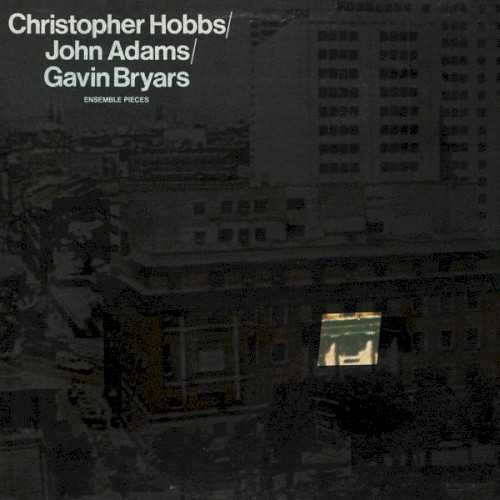 | Album: 1 of 24 Title: Ensemble Pieces Released: 1975 Tracks: 6 Duration: 00:00 Scroll: Up Down Top Bottom 25% 50% 75% Allmusic AlbumCover | 1 Aran (?) 2 John Philip Sousa (?) 3 Christian Zeal And Activity (?) 4 Sentimentals (?) 5 McCrimmon Will Never Return (?) 6 1, 2, 1-2-3-4 (?) |
| Ensemble Pieces : Allmusic album Review : Ensemble Pieces is a fascinating early collection of four pieces by three composers, two of whom would go on to achieve considerable popularity with works far less experimental than those captured here. Christopher Hobbs, who, at age 18, had become a member of the legendary improvising group AMM, was still in his mid-twenties when he composed the two striking pieces represented herein. "Aran" is a brief, extremely colorful for reed organs, percussion, and toy pianos that manages to evoke ancient Britain and contemporary minimalism at the same time in a delightful manner. His "McCrimmon Will Never Return," for two reed organs, similarly reminds one of Scottish bagpipe music while clearly owing a debt to Terry Rileys electric organ explorations. Nonetheless, it stands on its own as an absorbing work. John Adams "American Standard" is one of his earliest pieces and might be the first to be recorded. He uses references to certain brands of Americana (Sousa, religious hymns, and Ellingtons "Sophisticated Lady") as a basis for three thoughtful and provocative excursions into aspects of minimalism rarely visited. In the second section, subtitled "Christian Zeal and Activity," he uses a found tape of a radio talk show. One can see where Brian Eno, who produced this recording, may well have gotten the seed for his 1980 collaboration with David Byrne, My Life in the Bush of Ghosts. At the time of this recording, Gavin Bryars was still composing works of an extreme and imaginative experimental bent and the charmingly tilted, "1, 2, 1-2-3-4" is a wonderful example. The ten performers wear headphones over which their part is played. They are to play along as well as possible but, since they cannot hear their companions and due to the vagaries of cassette machines and speeds thereof, they necessarily go out of sync, possibly out of tune as well. The result is a dreamlike piece with generally jazz-based themes where the dislocations and disjunctions seem oddly natural and proper. | ||
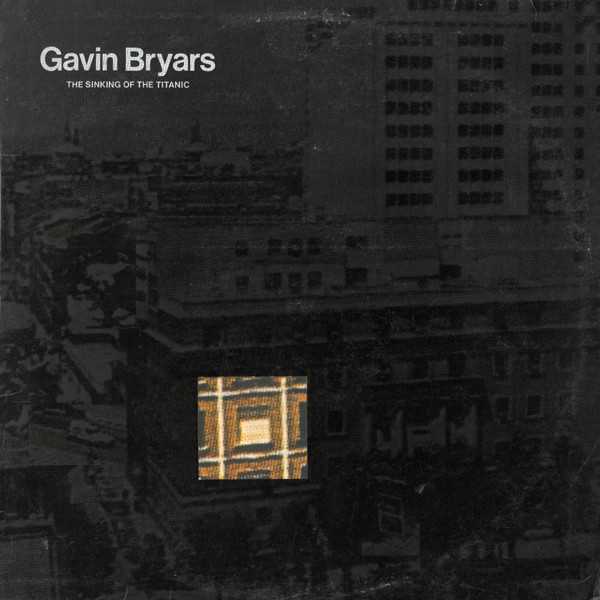 | Album: 2 of 24 Title: The Sinking of the Titanic / Jesus’ Blood Never Failed Me Yet Released: 1975 Tracks: 2 Duration: 50:28 Scroll: Up Down Top Bottom 25% 50% 75% Allmusic AlbumCover | 1 Jesus’ Blood Never Failed Me Yet (26:02) 2 The Sinking of the Titanic (24:26) |
| The Sinking of the Titanic / Jesus’ Blood Never Failed Me Yet : Allmusic album Review : A holy grail among contemporary music collectors, this release on Brian Enos Obscure label, which went out of print almost immediately, features two of the finest compositions of the late 20th century, both by Gavin Bryars. The title track had since been recorded again on two occasions, arguably to better effect on Les Disques du Crepuscule in 1990 and once, more pallidly, on Point in 1994, but this initial production was an extremely special event. Bryars idea was to construct an aural picture of the disaster, complete with songs and hymns supposedly played by the ships orchestra even as she was sinking. He combined this with the acoustical phenomenon of the enhanced ability of sounds to travel great lengths underwater and produced an eerie and romantic sub-aqueous soundscape of remarkable subtlety and beauty. Using minimalist techniques, the repetition and overlapping of hymns like "Autumn" assume a surreal aspect, at once sad and peaceful. His score was designed to incorporate new discoveries about the shipwreck (or to dispense with elements that proved false) over time; this performance includes taped reminiscences of one survivor and the tinklings of a music box salvaged by another. This is one gorgeous, haunting piece of music. As though one masterpiece wasnt enough, the second composition on the album might be even greater. Surely one of the most beautiful "concept" works ever created, "Jesus Blood Never Failed Me Yet" begins with the faint, faded-in voice of a London tramp singing the old hymn plaintively but without pathos and more or less in tune. Bryars looped this tape so that it resolved in non-jarring fashion, then introduced -- ever so softly and gradually with each iteration of the verse -- instrumental accompaniment: first strings, then guitar and bass, and eventually the entire chamber orchestra. The lush, sensuous music, entirely sympathetic to the song, gives it increased strength and humanity as it swells to near-majestic proportions and then, just as gradually, subsides. The emotional impact of this 25-minute piece, in its honest and charitable stance toward the singer, cannot be understated. With this simple idea, limned with precision and beauty, Bryars was graciously content to achieve a lofty goal one time, to let it stand by itself and move on. A version recorded for Point in 1995, which included the gratuitous addition of Tom Waits accompanying the tape, pales in comparison to the original. Long a collectors item on vinyl, a CD issue was released in England on Virgin U.K. in 1998 but it, too, quickly went out of print. | ||
 | Album: 3 of 24 Title: Irma Released: 1978 Tracks: 7 Duration: 00:00 Scroll: Up Down Top Bottom 25% 50% 75% AlbumCover | 1 Introduction (?) 2 Overture And Aria : "I Tell You Thats Irma Herself" (?) 3 First Interlude (?) 4 Aria: "Irma You Will Be Mine" (?) 5 Second Interlude (?) 6 Chorus: "Love Is Help Mate" (?) 7 Postlude (?) |
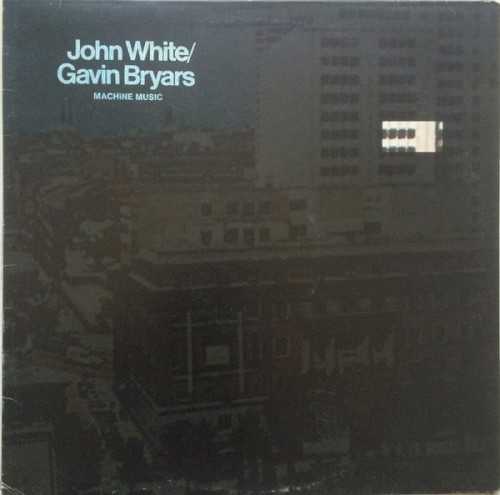 | Album: 4 of 24 Title: Machine Music Released: 1978 Tracks: 5 Duration: 00:00 Scroll: Up Down Top Bottom 25% 50% 75% AlbumCover | 1 Autumn Countdown Machine (?) 2 Son Of Gothic Chord (?) 3 Jews Harp Machine (?) 4 Drinking And Hooting Machine (?) 5 The Squirrel And The Ricketty Racketty Bridge (?) |
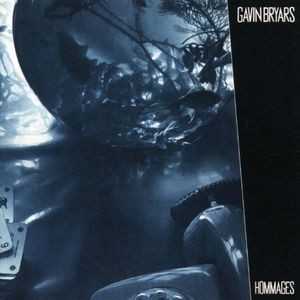 | Album: 5 of 24 Title: Hommages Released: 1981-11 Tracks: 4 Duration: 39:59 Scroll: Up Down Top Bottom 25% 50% 75% Spotify AlbumCover | 1 My First Homage (15:10) 2 The English Mail-Coach (03:14) 3 The Vespertine Park (11:04) 4 Hi-Tremolo (10:31) |
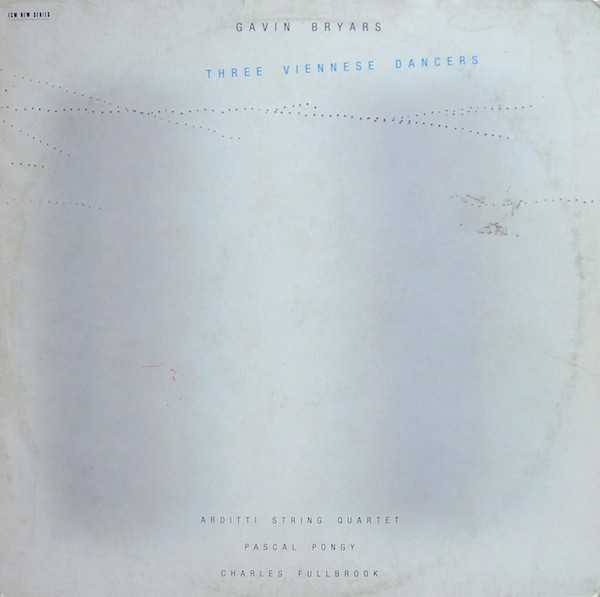 | Album: 6 of 24 Title: Three Viennese Dancers Released: 1987 Tracks: 4 Duration: 48:24 Scroll: Up Down Top Bottom 25% 50% 75% Spotify Allmusic AlbumCover | 1 Prologue (04:45) 2 String Quartet No. 1 ("Between the National and the Bristol") (20:09) 3 First Viennese Dance ("M. H.") (18:53) 4 Epilogue (04:36) |
| Three Viennese Dancers : Allmusic album Review : Gavin Bryars first recording for a widely distributed label found him midway between the more experimental works from his early career, recorded for Obscure and Les Disques du Crepuscule, and the later, more somberly romantic compositions of the 90s. The recording, oddly, begins and ends with exactly the same piece (despite their differing titles), a short, evocative composition for percussion and French horn, but it does provide an attractive set of bookends for the major piece here. The first is his "String Quartet No. 1," given a strong, precise, and impassioned reading by the Arditti Quartet. Bryars manages to achieve a subtle balance between the ghostly voicings of high-register strings and the subtle, underlying melancholy of the work. The "First Viennese Dance," a duo for French horn and percussion, seems to exist in some timeless, slightly northern clime, as one can imagine the horns cries wafting over a meadow of chimes, gongs, bells, and bowed cymbals. Here, unlike in some later works, Bryars is able to be at once mysterious yet crystal clear, sad but serene. Three Viennese Dancers is one of the last albums of his that one can recommend unequivocally. | ||
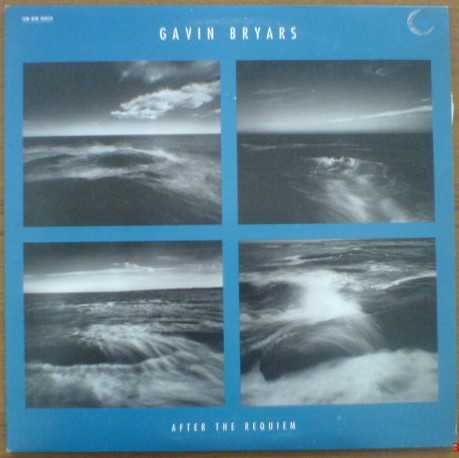 | Album: 7 of 24 Title: After the Requiem Released: 1991 Tracks: 4 Duration: 1:06:50 Scroll: Up Down Top Bottom 25% 50% 75% Spotify AlbumCover | 1 After the Requiem (15:48) 2 The Old Tower of Löbenicht (16:00) 3 Alaric I or II (15:15) 4 Allegrasco (19:46) |
 | Album: 8 of 24 Title: Jesus Blood Never Failed Me Yet Released: 1993 Tracks: 6 Duration: 1:14:42 Scroll: Up Down Top Bottom 25% 50% 75% Spotify Allmusic AlbumCover | 1 Jesus Blood Never Failed Me Yet: Tramp With Orchestra I (string quartet) (27:05) 2 Jesus Blood Never Failed Me Yet: Tramp With Orchestra II (low strings) (15:16) 3 Jesus Blood Never Failed Me Yet: Tramp With Orchestra III (no strings) (04:48) 4 Jesus Blood Never Failed Me Yet: Tramp With Orchestra IV (full strings) (06:06) 5 Jesus Blood Never Failed Me Yet: Tramp and Tom Waits With Full Orchestra (19:38) 6 Jesus Blood Never Failed Me Yet: Coda: Tom Waits With High Strings (01:47) |
| Jesus' Blood Never Failed Me Yet : Allmusic album Review : Out from the silence, a lone tramp raises his frail voice in song "Jesus blood never failed me yet, this one thing I know, for he loves me so...." Originally recorded as footage for a documentary that was never released, this unidentified mans voice serves as both a backdrop and a centerpiece for Gavin Bryars touching but challenging epic, running over 74 minutes in length. Some critics prefer the out-of-print 1975 recording (released on Brian Enos Obscure Records label) because it was shorter, though Bryars personally felt limited by the time restrictions of vinyl pressings. When compact discs hit the scene, he set about to lengthen and re-orchestrate the piece and make the most of the format. This newer version on Point Music still inches along gracefully enough, but over time listeners may identify more and more with the hobos fatigue. The field recording of the old man is quoted to be a favorite of junkyard minstrel Tom Waits, who shows up here near the finale of the piece to sing alongside and around the tramp in unison and in counter melodies. In the final minutes, Waits is left to sing alone with high strings, only to wander off into the cavernous darkness from which the piece came. This melancholy and repetitive disc may test the patience as it wears on, though Bryars squeezes every drop of sweetness he can into the slowly shifting score. It is said that no matter how many different ways you paint a house, it is still essentially the same house. Here, it is the hobos verse that holds the piece together, but ironically its also the thing that keeps it from taking flight with its relentless constancy; it is repeated over 150 times. The meditative and haunting qualities this disc should have run dry quickly, but if the concept of this piece is intriguing, turn instead to Bryars far superior piece, "The Sinking of the Titanic," for a more rewarding experience. | ||
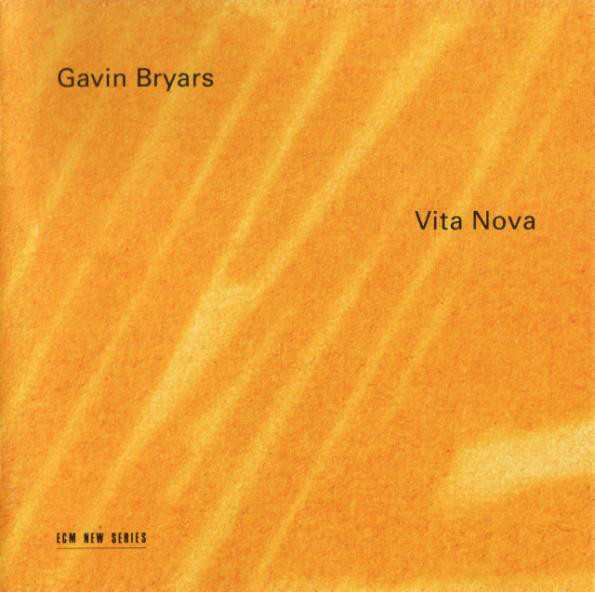 | Album: 9 of 24 Title: Vita Nova Released: 1994 Tracks: 4 Duration: 56:37 Scroll: Up Down Top Bottom 25% 50% 75% Spotify Allmusic AlbumCover | 1 Incipit Vita Nova (06:07) 2 Glorious Hill (11:39) 3 Four Elements (28:53) 4 Sub Rosa (09:57) |
| Vita Nova : Allmusic album Review : Vita Nova includes four pieces by Bryars in which ECM appeared to be, at least partially, attempting to cash in on the new age-y vogue of the early 90s for the sort of quasi-medieval music made relatively popular by assorted singing monks, Arvo Pärt, and the Hilliard Ensemble with Jan Garbarek. Indeed, that latter group is on hand here to perform "Glorious Hill," and the results are as blandly attractive as the listener might guess given the following recipe: Take a mushily mystical text (in Latin), set to vaguely medieval sounding music, and spice with a dash of chromaticism and a pinch of minimalism. Its all handsomely produced and sung but terribly precious and overly palatable. How far Bryars had come from the rich reality of the tramp singing "Jesus Blood Never Failed Me Yet" in his masterpiece from the 70s. Unfortunately, the remainder of the disc also fails to deliver much more than prettiness. The longest composition, "Four Elements," falls into the same gauzily impressionistic, rudderless rut of much of his 90s work, and the introduction of David James, the same countertenor used in "Incipit Vita Nova," seems tacked on just to fit in with the ostensible "medieval" feel of the album. The same applies to the use of a recorder on the final piece, "Sub Rosa." That work, however, does contain glimmers of the unique beauty and clarity of Bryars earlier work as found on Hommages. But those instances are far too meager to be able to recommend this recording to anyone but listeners attempting to slowly crawl their way out of the new age morass. | ||
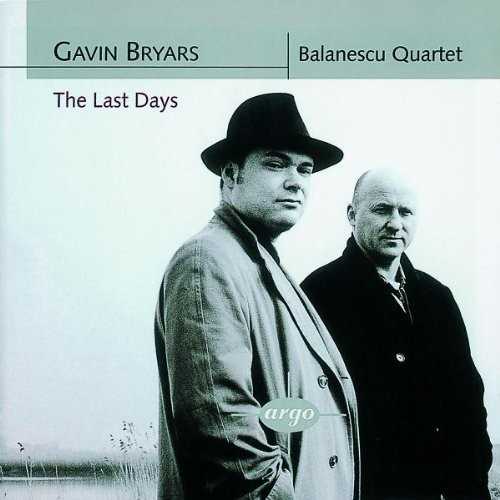 | Album: 10 of 24 Title: The Last Days Released: 1995-11-14 Tracks: 7 Duration: 1:12:49 Scroll: Up Down Top Bottom 25% 50% 75% Spotify Allmusic AlbumCover | 1 String Quartet no. 1 ("Between the National and the Bristol") (22:03) 2 Die Letzten Tage ("The Last Days"): Prelude (The Roman Ending) (04:09) 3 Die Letzten Tage ("The Last Days"): I. The Venetian Beginning (05:44) 4 Die Letzten Tage ("The Last Days"): Intermezzo I (04:18) 5 Die Letzten Tage ("The Last Days"): Intermezzo II (04:10) 6 Die Letzten Tage ("The Last Days"): II. The Corinthian Middle (08:36) 7 String Quartet no. 2 (23:46) |
| The Last Days : Allmusic album Review : The Last Days consists of the title composition (a piece for two violins) and Bryars "String Quartet No. 1" and "String Quartet No. 2." The first quartet (from 1985), previously recorded by the Arditti Quartet on the ECM release Three Viennese Dances, features sweeping, romantic melodic lines over minimalistically pulsing rhythms. Bryars penchant for moody, melancholy ruminations is in full effect, though the final section, with its retuned strings entering airy harmonic territories, hints at sublime rapture. The basic material in "The Last Days" (1992) doesnt sound too different from the first quartet, though the work is broken into five portions, lending them more the quality of songs, even arias. However, the romantic surge is somewhat sublimated and a stately aura is almost achieved, which robs the music of greater emotional impact. The second string quartet begins where the first left off: in the upper atmosphere. It briefly settles into an enticingly turbulent give and take but soon reenters the general sound areas of the earlier work, replete with plaintive violin lines over those pulsating cellos. Some differences in technique are apparent, including the use of bottleneck slides, but the overall result, while not without its pleasures, seems to tread -- and retread -- too much water. | ||
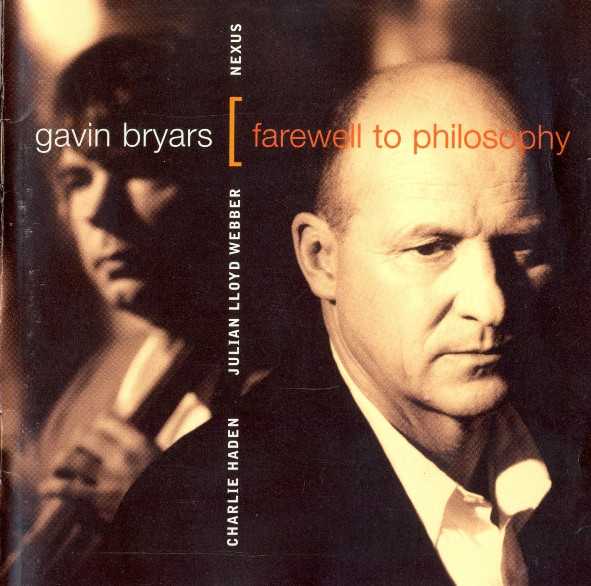 | Album: 11 of 24 Title: Farewell to Philosophy Released: 1996-09-26 Tracks: 13 Duration: 1:15:05 Scroll: Up Down Top Bottom 25% 50% 75% Spotify AlbumCover | 1 Cello Concerto "Farewell to Philosophy": I. (09:12) 2 Cello Concerto "Farewell to Philosophy": II. Piu mosso (04:52) 3 Cello Concerto "Farewell to Philosophy": III. (04:36) 4 Cello Concerto "Farewell to Philosophy": IV. (02:04) 5 Cello Concerto "Farewell to Philosophy": V. The Philosopher (02:09) 6 Cello Concerto "Farewell to Philosophy": VI. Poco meno mosso (06:10) 7 Cello Concerto "Farewell to Philosophy: VII. "Farewell": a tempo (06:03) 8 One Last Bar, Then Joe Can Sing: I. Lento (08:27) 9 One Last Bar, Then Joe Can Sing: II. Piu mosso (07:42) 10 One Last Bar, Then Joe Can Sing: III. Coda (02:52) 11 By the Vaar: I. (08:39) 12 By the Vaar: II. (09:01) 13 By the Vaar: III. Epilogue (03:12) |
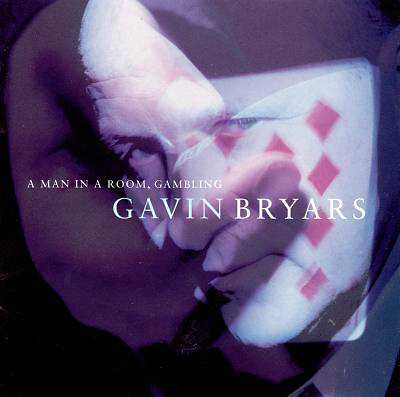 | Album: 12 of 24 Title: A Man in a Room, Gambling Released: 1997-04-07 Tracks: 10 Duration: 51:38 Scroll: Up Down Top Bottom 25% 50% 75% Spotify AlbumCover | 1 Bottom Dealing (05:10) 2 Three Card Trick (05:10) 3 Cutting (05:10) 4 Shifting Upper Pack to Bottom (05:10) 5 Sorting 3 Cards in a Pack (05:10) 6 Taking Cards From the Bottom (05:10) 7 Sorting 2 Cards in a Pack (05:10) 8 Getting Rid of Extra Cards (05:10) 9 Three Card Trick / The Mexican Row (05:10) 10 Dealing From the Bottom (05:08) |
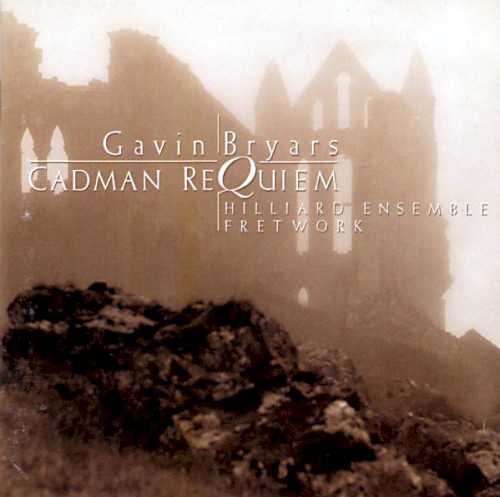 | Album: 13 of 24 Title: Cadman Requiem Released: 1999-01-12 Tracks: 14 Duration: 1:01:17 Scroll: Up Down Top Bottom 25% 50% 75% AlbumCover | 1 Cadman Requiem: Requiem (09:18) 2 Cadman Requiem: Caedmon Paraphrase (Bede) (03:06) 3 Cadman Requiem: Agnus Dei (05:06) 4 Cadman Requiem: Caedmons "Creation Hymn" (02:22) 5 Cadman Requiem: In Paradisum (05:25) 6 Adnan Songbook: Song I (03:24) 7 Adnan Songbook: Song II (04:23) 8 Adnan Songbook: Song III (03:17) 9 Adnan Songbook: Song IV (01:34) 10 Adnan Songbook: Song V (04:04) 11 Adnan Songbook: Song VI (03:14) 12 Adnan Songbook: Song VII (03:08) 13 Adnan Songbook: Song VIII (05:33) 14 Epilogue from Wonder Lawn (07:17) |
 | Album: 14 of 24 Title: A Portrait Released: 2002-12-02 Tracks: 24 Duration: 2:30:18 Scroll: Up Down Top Bottom 25% 50% 75% AlbumCover | 1 Cello Concerto (Farewell to Philosophy): Bar 1 (feat. cello: Julian Lloyd Webber) (09:13) 2 Cello Concerto (Farewell to Philosophy): Bar 100, Più Mosso (feat. cello: Julian Lloyd Webber) (04:53) 3 Cello Concerto (Farewell to Philosophy): Bar 222 (feat. cello: Julian Lloyd Webber) (04:37) 4 Cello Concerto (Farewell to Philosophy): Bar 293 (feat. cello: Julian Lloyd Webber) (02:04) 5 Cello Concerto (Farewell to Philosophy): Bar 324, "The Philosopher" (feat. cello: Julian Lloyd Webber) (02:09) 6 Cello Concerto (Farewell to Philosophy): Bar 354, Poco Meno Mosso (feat. cello: Julian Lloyd Webber) (06:11) 7 Cello Concerto (Farewell to Philosophy): Bar 426, "Farewell" a Tempo (feat. cello: Julian Lloyd Webber) (06:03) 8 One Last Bar Then Joe Can Sing: Bar 1, Lento (08:28) 9 One Last Bar Then Joe Can Sing: Bar 107, Più Mosso (07:42) 10 One Last Bar Then Joe Can Sing: Bar 238, Coda (02:55) 11 Les Fiançailles (18:45) 12 Jesus Blood Never Failed Me Yet (04:05) 1 The Green Ray (21:28) 2 Adnan Songbook: Song I (03:26) 3 Adnan Songbook: Song II (04:22) 4 Adnan Songbook: Song III (03:17) 5 Adnan Songbook: Song IV (01:35) 6 Adnan Songbook: Song V (04:04) 7 Adnan Songbook: Song VI (03:14) 8 Adnan Songbook: Song VII (03:12) 9 Adnan Songbook: Song VIII (05:31) 10 The Sinking of the Titanic (04:07) 11 The North Shore (14:52) 12 Jesus Blood Never Failed Me Yet (single remix) (04:02) |
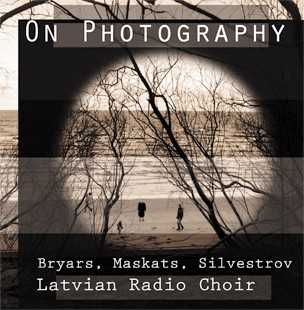 | Album: 15 of 24 Title: On Photography Released: 2005-06-14 Tracks: 10 Duration: 1:10:37 Scroll: Up Down Top Bottom 25% 50% 75% AlbumCover | 1 And So Ended Kants Travelling in this World (08:01) 2 Three Poems of Cecco Angiolieri: La mia malinconia... (03:47) 3 Three Poems of Cecco Angiolieri: Si fosse foco... (04:42) 4 Three Poems of Cecco Angiolieri: La stremita... (05:34) 5 Da ispravitsja molitva moja (09:14) 6 On Photography: Expressa Solis (02:37) 7 On Photography: Expressa Solis / Tersa Perfetta (17:14) 8 On Photography: Resonare fibris... (03:34) 9 Diptychon: The Lords Prayer (05:40) 10 Diptychon: Testament (10:14) |
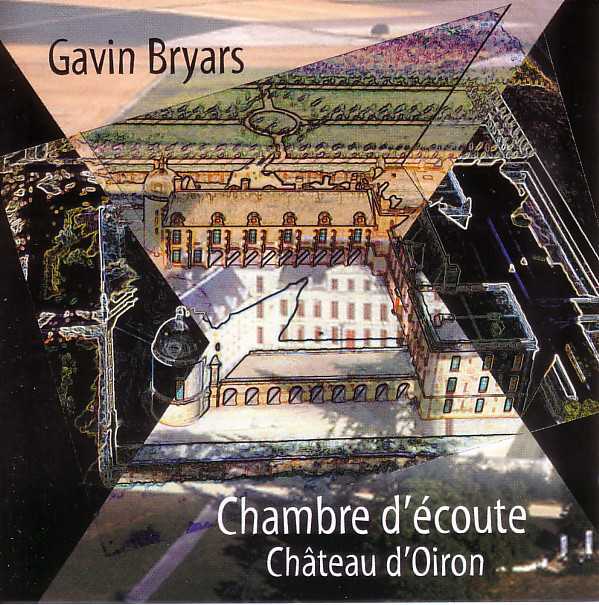 | Album: 16 of 24 Title: A Listening Room (Chambre découte) Released: 2006 Tracks: 9 Duration: 56:06 Scroll: Up Down Top Bottom 25% 50% 75% AlbumCover | 1 Espace de la cour (03:15) 2 Cage du grand escalier (08:46) 3 Salon des emigres (04:50) 4 Galerie des peintures (06:08) 5 Tour des Ondes (06:47) 6 Cuisine (10:23) 7 Vestibule (04:48) 8 Salle darmes (06:52) 9 Salle des Faïences / Salon Gris (04:17) |
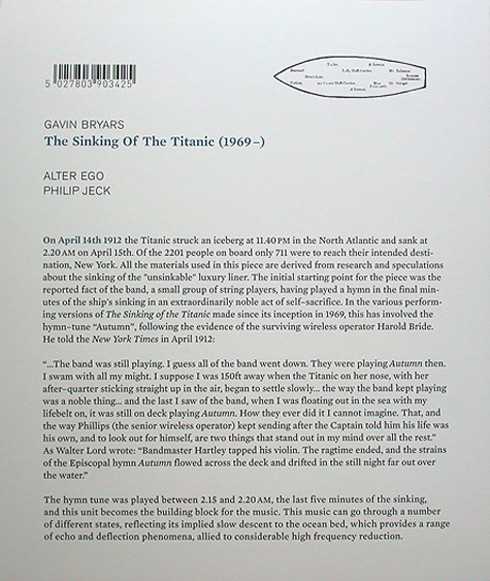 | Album: 17 of 24 Title: The Sinking of the Titanic Released: 2007-11 Tracks: 1 Duration: 1:12:35 Scroll: Up Down Top Bottom 25% 50% 75% AlbumCover | 1 The Sinking of the Titanic (1:12:35) |
 | Album: 18 of 24 Title: Sentieri Selvaggi Plays Gavin Bryars & Philip Glass Released: 2008 Tracks: 2 Duration: 16:29 Scroll: Up Down Top Bottom 25% 50% 75% AlbumCover | 1 Sub Rosa (08:31) 2 Facades (07:58) |
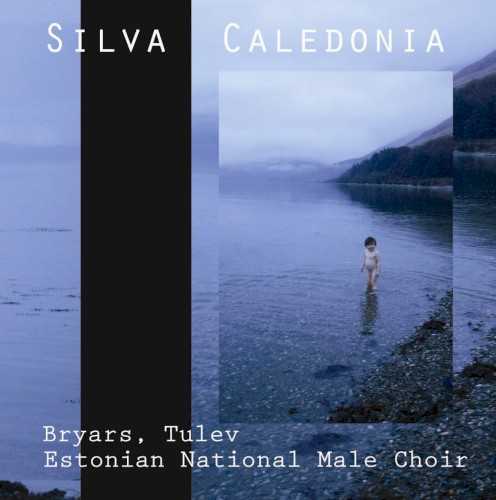 | Album: 19 of 24 Title: Silva Caledonia Released: 2008 Tracks: 6 Duration: 1:04:30 Scroll: Up Down Top Bottom 25% 50% 75% Spotify AlbumCover | 1 Double Bass Concerto "Farewell to St Petersburg" (28:17) 2 Memento (02:52) 3 Silva Caledonia (05:44) 4 O Oriens (11:47) 5 The Summons (06:30) 6 Ian in the Broch (09:19) |
 | Album: 20 of 24 Title: Piano Concerto, "The Solway Canal" / After Handels Vesper / Ramble on Cortona Released: 2011 Tracks: 3 Duration: 52:39 Scroll: Up Down Top Bottom 25% 50% 75% AlbumCover | 1 After Handels Vesper (version for piano) (11:48) 2 Ramble on Cortona (12:32) 3 Piano Concerto, "The Solway Canal" (28:19) |
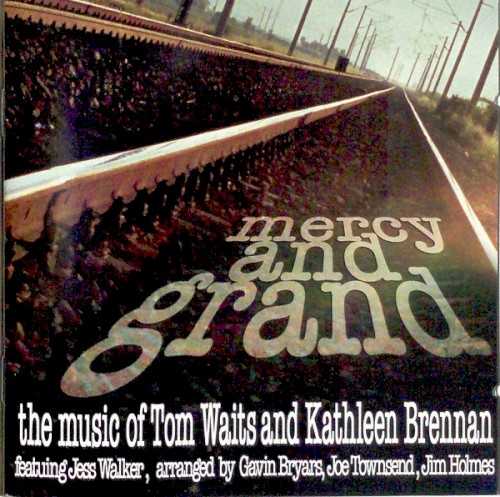 | Album: 21 of 24 Title: Mercy and Grand Released: 2012-04-23 Tracks: 19 Duration: 1:13:47 Scroll: Up Down Top Bottom 25% 50% 75% AlbumCover | 1 Gypsy Tango (02:22) 2 A Little Drop of Poison (03:11) 3 The Threepenny Opera: Ballad of Sexual Dependency (02:53) 4 Poor Edward (03:24) 5 Alice (05:36) 6 Whistle Down the Wind (04:22) 7 A Little Rain (03:33) 8 Innocent When You Dream (02:42) 9 Johnsburg, Illinois (02:02) 10 La Partida (02:59) 11 What Keeps Mankind Alive (05:31) 12 Pony (05:58) 13 Georgia Lee (03:55) 14 Broken Bicycles (04:00) 15 Train Song (03:27) 16 Pull Down Lads (05:00) 17 Barbara Allen (03:31) 18 The Briar and the Rose (06:04) 19 Lullaby (03:17) |
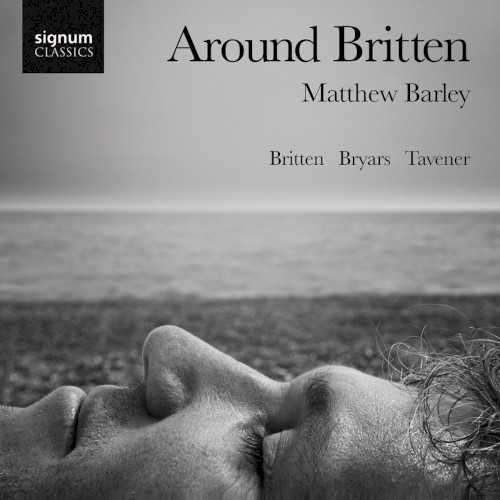 | Album: 22 of 24 Title: Around Britten Released: 2013-01-14 Tracks: 24 Duration: 1:12:19 Scroll: Up Down Top Bottom 25% 50% 75% Allmusic AlbumCover | 1 Third Suite for Cello, op. 87: I Introduzione: Lento (02:10) 2 Third Suite for Cello, op. 87: II Marcia: Allegro (01:49) 3 Third Suite for Cello, op. 87: III Canto: Con moto (01:19) 4 Third Suite for Cello, op. 87: IV Barcarola: Lento (01:33) 5 Third Suite for Cello, op. 87: V Dialogo: Allegretto (01:42) 6 Third Suite for Cello, op. 87: VI Fuga: Andante espressivo (02:55) 7 Third Suite for Cello, op. 87: VII Recitativo: Fantastico (01:07) 8 Third Suite for Cello, op. 87: VIII Moto Perpetuo: Presto (00:57) 9 Third Suite for Cello, op. 87: IX Passacaglia: Lento solenne (04:25) 10 Third Suite for Cello, op. 87: Mournful Song (00:33) 11 Third Suite for Cello, op. 87: Autumn (00:19) 12 Third Suite for Cello, op. 87: Street Song (00:26) 13 Third Suite for Cello, op. 87: Depart in Peace, with the Saints (Kontakion) (02:42) 14 Greensleeves (02:06) 15 The Salley Gardens (02:33) 16 Tre Laude Dolce: I. (06:26) 17 Tre Laude Dolce: II. (05:18) 18 Tre Laude Dolce: III. (05:47) 19 Since She Whom I Loved (03:28) 20 Threnos (07:12) 21 Chant (04:25) 22 Concord (02:26) 23 Improvisation (09:52) 24 Oliver Cromwell (00:49) |
| Around Britten : Allmusic album Review : This release by British cellist Matthew Barley serves admirably as a solo cello recording that doesnt bog down over the course of 70-plus minutes, and theres more to recommend it as well. The album consists mostly of music by Britten himself, with examinations of his influence in two different directions represented by Gavin Bryars and John Tavener. Barley picks fairly obscure works by Britten that seem to illuminate the essentially personal nature of his work. The highlight is the Third Suite for cello, Op. 87, composed for Mstislav Rostropovich in 1971, five years before Brittens death. The work originated during Brittens stay in the Soviet Union, and it is based on a Russian Orthodox melody, the Kontakion, that appears in full only at the end of the work. No word on what Brittens Soviet hosts thought of this during a period when religious expression was strongly discouraged, but the work does not come off as really Russian in flavor; instead, the ailing Britten seems to have been attracted by the transcendent mood of the melody, and he produced a work that carries the flavor of seeming to approach the moment of transcendence from different directions. Barley finds an intriguing way of asserting Brittens continued relevance to a young musician steeped in modern technology: he plays several of Brittens arrangements of folk songs in rearranged versions for his own single cello, multi-tracked. Few would claim the music on this release as top-rank Britten, but Barley makes an extremely imaginative case for it. | ||
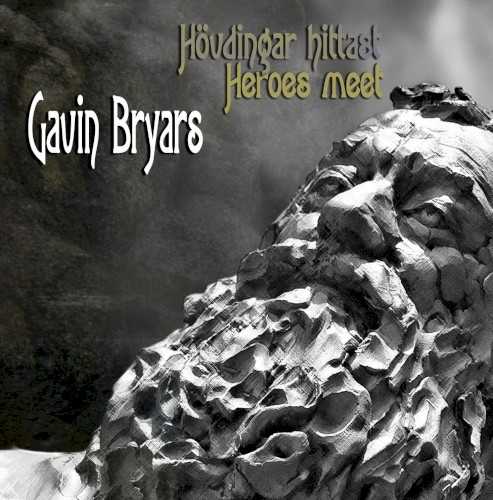 | Album: 23 of 24 Title: Hövdingar hittast (Heroes meet) Released: 2014-05-11 Tracks: 18 Duration: 1:06:35 Scroll: Up Down Top Bottom 25% 50% 75% AlbumCover | 1 From Egils Saga, Prologue (04:09) 2 From Egils Saga part I. To Erik in York: “Vestr fórk of ver…” (“By sun and moon…”) (To Erik in York) (07:55) 3 From Egils Saga part II. Lament for my Sons: “Mjök erum tregt…” (“My mouth strains…”) (05:41) 4 From Egils Saga part II. Lament for my Sons: “Attak gótt…” (“The spear-god shared…”) (02:37) 5 From Egils Saga part II. Lament for my Sons: “Nú erum torvelt” (“The end is all”) (03:22) 6 From Egils Saga part III. In honor of Aribjorn: “Hann aldrteig…” (“A fertile field…”) (03:57) 7 From Egils Saga part IV. Late Poems: “Vals hefk vófur helsis…” (“My bald pate bobs and blunders…”) (03:23) 8 From Egils Saga part II. Lament for my Sons: “Nu erum torvelt” (“The end is all” reprise) (03:06) 9 Hitt blinda liðið (The Company of the Blind) (03:45) 10 Tróndur í Gøtu: The Journey Prayer (St. Brendan) (03:56) 11 Tróndur í Gøtu: The Island of Birds (St Brendan) (03:15) 12 Tróndur í Gøtu: “I Føroyum búðu menskir fyrr…” (“In bygone times, the Faroes…”) (05:55) 13 Tróndur í Gøtu: Tróndur’s Creed I (01:52) 14 Tróndur í Gøtu: St. Brendan’s Prayer (04:45) 15 Tróndur í Gøtu: “Hevjið í Homrum” (“Raise the Vociferous Chant”) (01:25) 16 Tróndur í Gøtu: “Streyk Tróndur Saer Um Ennið” (“Trondur Strokes His Forehead”) (02:58) 17 Tróndur í Gøtu: Tróndur’s Creed II (01:38) 18 Tróndur í Gøtu: “Tróndur doyði…” (“Trondur Died…”) (02:48) |
 | Album: 24 of 24 Title: Perpetulum Released: 2019-03-29 Tracks: 14 Duration: 1:33:42 Scroll: Up Down Top Bottom 25% 50% 75% AlbumCover | 1 Aliens With Extraordinary Abilities: Torched and Wrecked (04:31) 2 Aliens With Extraordinary Abilities: Agreed (04:27) 3 Aliens With Extraordinary Abilities: Take Anything You Want (04:40) 4 Aliens With Extraordinary Abilities: Donner (06:25) 5 Aliens With Extraordinary Abilities: Dont Eat Your Young (04:55) 6 Aliens With Extraordinary Abilities: Things May Be Changing (But Probably Not) (03:33) 7 Aliens With Extraordinary Abilities: Triptan (06:15) 1 Bend (08:01) 2 Perpetulum: Part 1 (06:52) 3 Perpetulum: Part 2 (06:22) 4 Perpetulum: Cadenza (02:44) 5 Perpetulum: Part 3 (05:25) 6 Ordering-Instincts (07:48) 7 The Other Side of the River (21:44) |